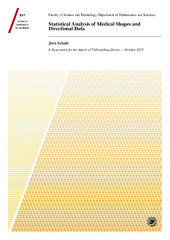Statistical Analysis of Medical Shapes and Directional Data
Permanent link
https://hdl.handle.net/10037/5869View/
Thesis introduction (PDF)
Schulz, Jörn, Skrøvseth, Stein Olav, Tømmerås, Veronika Kristine, Marienhagen, Kirsten and Godtliebsen, Fred: 'A semiautomatic tool for prostate segmentation in radiotherapy treatment planning' (manuscript). Later published in BMC Medical Imaging (2014), 14:4 (PDF)
Schulz, Jörn, Jung, Sungkyu, Huckemann, Stephan, Pierrynowski, Michael, Marron, J.S. and Pizer, Stephen M.: 'Analysis of rotational deformations from directional data' (manuscript). Later published in Journal of Computational and Graphical Statistics, 24(2), 539-560, 2015 (PDF)
Schulz, Jörn, Pizer, Stephen M., Marron, J.S. and Godtliebsen, F.: 'Nonlinear hypothesis testing of geometrical object properties of shapes applied to hippocampi' (manuscript). Later published in Journal of Mathematical Imaging and Vision, 54(1), 15-34, 2016 (PDF)
Entire thesis in one comprehensive file. (PDF)
Date
2013-12-18Type
Doctoral thesisDoktorgradsavhandling
Author
Schulz, JörnAbstract
The use of statistical shape analysis in medical settings has increased during the last decades. This thesis presents contributions to three major topics of statistical shape analysis with application to medical problems. These topics are: the modeling of the shape by a geometrical model, the study of rotational shape deformations and the comparison of shapes between populations.
Paper I presents a semiautomatic method for the prostate segmentation in radiotherapy treatment planning. To facilitate the manual delineation of the prostate in medical images, an intuitive approach is developed for 3D modeling of the prostate by slice-wise best fitting ellipses in each image. The focus is to estimate a mean shape from a set of training data and to register the estimate by the definition of a few control points in a new patient. The obtained results are fairly accurate and suggest possible time saving effects.
Paper II studies rotational deformations of objects. The rotational deformations such as twisting or bending have been observed as the major variations in some medical applications, where the features of the deformed 3D objects are directional data. Models and estimators are proposed for one or the composition of two simple deformations based on the directional features. The proposed method uses a generalized small circle fitting on the unit sphere. Two analyses of 3D object data are presented: one using skeletal representations in medical image analysis as well as one from biomechanical gait analysis of the knee joint.
Paper III investigates shape mean differences between two populations using a hypothesis test. Several aspects of a sensitive hypothesis test are elaborated which support accurate statistics of populations. A novel permutation test is developed for data whose representations include both Euclidean and non-Euclidean elements. By supporting non-Euclidean components, the proposed hypothesis test is novel in the study of morphological shape differences. Both global and local analyses showed statistically significant differences between first episode schizophrenics and controls and demonstrated the sensitivity of the method.
Publisher
UiT Norges arktiske universitetUiT The Arctic University of Norway
Metadata
Show full item recordCollections
Copyright 2013 The Author(s)
The following license file are associated with this item:
Except where otherwise noted, this item's license is described as Attribution-NonCommercial-ShareAlike 3.0 Unported (CC BY-NC-SA 3.0)
Related items
Showing items related by title, author, creator and subject.
-
Geometric Modeling- and Sensor Technology Applications for Engineering Problems
Pedersen, Aleksander (Doctoral thesis; Doktorgradsavhandling, 2020-10-20)In applications for technical problems, Geometric modeling and sensor technology are key in both scientific and industrial development. Simulations and visualization techniques are the next step after defining geometry models and data types. This thesis attempts to combine different aspects of geometric modeling and sensor technology as well as to facilitate simulation and visualization. It includes ... -
Engineering methods for enhancing railway geometry and winter road assessment: A safety and maintenance perspective
Brustad, Tanita Fossli (Doctoral thesis; Doktorgradsavhandling, 2020-06-22)In many areas around the world there are limited transportation possibilities when travelling between key cities. If these areas also experience demanding weather conditions or geography, getting from A to B, during difficult conditions, is usually not optimal in regards to accessibility, safety, and comfort. Under challenging conditions, two essential elements in strengthening accessibility, safety, ... -
Iceberg Drift-Trajectory Modelling and Probability Distributions of the Predictions
Baadshaug, Ole (Master thesis; Mastergradsoppgave, 2018-06-29)Moving icebergs represent a major problem for shipping, as well as for oil and gas installations in ice infested waters. To be able to take actions against hazardous icebergs, it is necessary to develop models for prediction of iceberg drift trajectories. Many models have been developed in order to do so, using different approaches. These approaches can be divided into two main categories, dynamic ...


 English
English norsk
norsk



